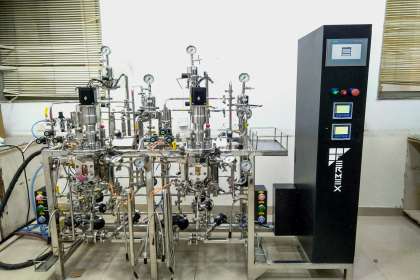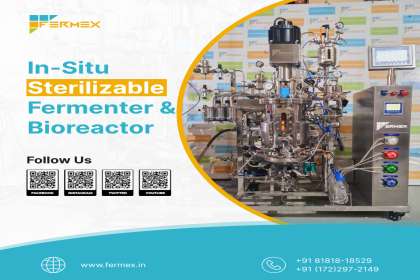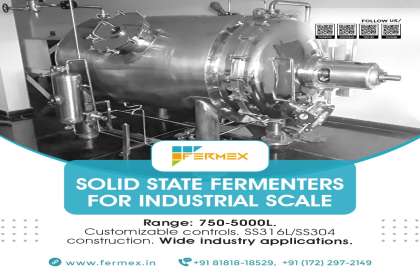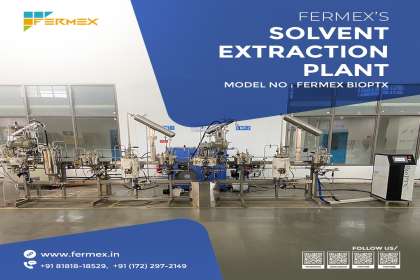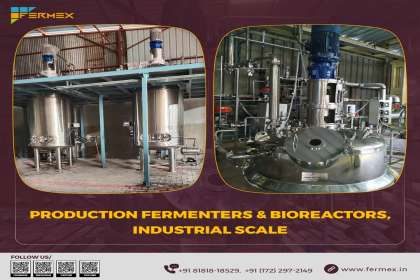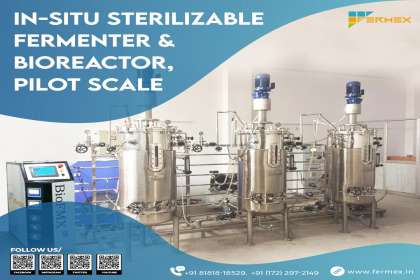Maximizing Secondary Metabolite Production

Use of Fermenter in Secondary Metabolites Production: –
A fermenter, also known as a bioreactor, is a vessel used for the cultivation of microorganisms, such as bacteria, yeast, or fungi, to produce various products, including secondary metabolites. Secondary metabolites are organic compounds produced by microorganisms that are not essential for their growth but often have pharmaceutical, agricultural, or industrial applications. Fermenters provide an optimized environment for the growth and metabolic activity of these microorganisms, allowing for efficient production of secondary metabolites.
- By utilizing fermenters, the production of secondary metabolites can be scaled up from laboratory scale to commercial scale, enabling efficient and controlled manufacturing processes. Fermenters provide an optimal environment for microorganism growth and metabolic activity, resulting in higher yields and improved productivity for the production of valuable secondary metabolites.
Key stages involved in the process of making Secondary Metabolites using Fermenters
The process of making secondary metabolites using fermenters involves several key stages. Here are the main stages involved:
1. Strain Selection: The first step is to identify and select a suitable microorganism strain that has the ability to produce the desired secondary metabolite. This may involve screening various strains or using genetically modified organisms to enhance production.
2. Inoculum Preparation: A small quantity of the selected microorganism strain is cultured in a suitable growth medium to obtain an inoculum. This step allows the microorganisms to multiply and reach an optimal population size before being transferred to the main fermenter.
3. Fermenter Setup: The main fermenter, or bioreactor, is prepared by sterilizing it to create a sterile environment. This involves cleaning the vessel and its components, as well as sterilizing the nutrient medium and any necessary equipment.
4. Medium Preparation: A nutrient-rich medium is formulated to provide the necessary nutrients for the growth and metabolism of the microorganism. The composition of the medium may vary depending on the specific requirements of the microorganism and the secondary metabolite being produced.
5. Inoculation: The prepared inoculum is introduced into the sterile fermenter containing the nutrient medium. The inoculum is carefully added to ensure even distribution of the microorganisms throughout the medium.
6. Fermentation Process: The fermentation process begins after inoculation. The conditions inside the fermenter are carefully controlled and optimized to promote the growth and metabolic activity of the microorganisms. This includes controlling parameters such as temperature, pH, dissolved oxygen levels, and agitation.
7. Sampling and Monitoring: Throughout the fermentation process, samples are taken at regular intervals to monitor the growth of the microorganisms and the production of the secondary metabolite. Various analytical techniques are employed to measure parameters such as biomass concentration, product yield, and purity.
8. Harvesting: Once the fermentation process is complete and the desired secondary metabolite has been produced, the microorganisms are separated from the fermentation broth. This can be achieved through techniques such as centrifugation, filtration, or sedimentation.
9. Downstream Processing: After harvesting, the secondary metabolite is extracted and purified from the biomass and fermentation broth. This involves various techniques such as solvent extraction, chromatography, crystallization, or distillation to isolate and purify the secondary metabolite.
10. Product Formulation and Packaging: The purified secondary metabolite is further processed and formulated into the desired end product, such as a drug, cosmetic ingredient, or food additive. It may undergo additional processing steps like drying, formulation, or encapsulation before being packaged for distribution.


Fermex Solutions LLP manufactures fermenters that can be used for these productions.
- Glass Autoclavable Fermenter (Lab scale)
- In situ Solid State Fermenter (Industrial scale)
- In situ Submerged Fermenter (Pilot scale)
- In situ Submerged Fermenter (Industrial Scale)
Benefits of Fermenters in the Production of Secondary Metabolites
Fermenters play a crucial role in the production of secondary metabolites, offering several benefits that contribute to the efficiency and success of the process. Here are some key benefits of using fermenters in the production of secondary metabolites:
1. Controlled Environment: Fermenters provide a controlled environment for microbial growth and metabolism. Parameters such as temperature, pH, dissolved oxygen, and agitation can be precisely regulated to optimize the conditions for the production of secondary metabolites. This control allows for consistent and reproducible production, ensuring batch-to-batch uniformity.
2. Scalability: Fermenters enable the scale-up of production from laboratory-scale to industrial-scale. They come in various sizes, ranging from small-scale benchtop fermenters to large industrial fermenters with high-volume capacity. This scalability allows for increased production volumes, meeting the demand for secondary metabolites in commercial applications.
3. High Yields: Fermenters provide an optimized environment for microbial growth, leading to increased biomass production and higher yields of secondary metabolites. By controlling key parameters, nutrient availability, and other growth conditions, fermenters can enhance the metabolic activity of microorganisms, resulting in improved productivity and greater secondary metabolite production.
4. Enhanced Productivity: Fermenters facilitate continuous or batch fermentation processes, enabling efficient utilization of resources and reduced production time. Continuous fermentation allows for a continuous supply of fresh nutrients and removal of waste products, promoting higher productivity. Batch fermentation, on the other hand, allows for the production of secondary metabolites in discrete batches, with each batch optimized for maximum yield.
5. Process Monitoring and Control: Fermenters are equipped with sensors and monitoring systems that enable real-time monitoring of various parameters. This includes measuring parameters such as biomass concentration, dissolved oxygen levels, pH, and nutrient consumption. By closely monitoring the fermentation process, deviations or issues can be detected early, allowing for timely interventions and adjustments to ensure optimal production conditions.
6. Sterility and Contamination Control: Fermenters are designed to maintain a sterile environment, minimizing the risk of contamination by unwanted microorganisms. The vessels and associated equipment undergo thorough sterilization procedures before use. This controlled environment reduces the likelihood of contamination, ensuring the purity and integrity of the secondary metabolite product.
7. Process Flexibility and Optimization: Fermenters offer flexibility in process optimization and customization. The fermentation conditions can be adjusted based on the specific requirements of the microorganism and the secondary metabolite being produced. This allows for fine-tuning of parameters to maximize product yield, purity, and quality.
8. Safety and Environmental Considerations: Using fermenters in secondary metabolite production provides a safer alternative to traditional extraction methods from natural sources. It reduces the reliance on resource-intensive and potentially harmful extraction processes while minimizing the impact on natural ecosystems.









